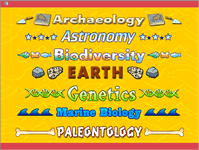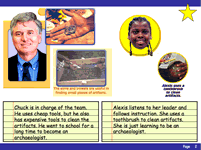Identify Relationships, Find Connections, Make Comparisons
Shift the focus from identifying relationships to using this information in new situations.
- Example. How is a BLANK like and unlike a BLANK?
- Example. Why do you think BLANK and BLANK belong together?
Young people need to be able to analyze and apply nonfiction information. They must also be able to make inferences from information through personal and content connections. Help children create connections by providing scaffolding for their inquiry such as guiding questions, concept maps, and examples.
Key words: analyzes, applies, appraise, breaks down, calculate, categorize, changes, chooses, compares, computes, construct, contrasts, deconstructs, demonstrates, differentiates, discriminates, distinguishes, dramatize, diagrams, illustrates, interpret, manipulates, modifies, operates, outlines, predictions, prepares, produces, relates, selects, separates, sketches, shows, solves, synthesize, uses, visualize.
Identify Relationships
Young people need to learn how to identify relationships in nonfiction. Identifying cause and effect relationships are difficult for children of all ages. Try different approaches to cause/effect such as varied Kidspiration and Inspiration templates.
Standards
- Standards
- English Standard 2.2.6. Recognize cause-and-effect relationships in a text. (Core Standard)
- English Standard 3.2.8. Distinguish between cause and effect and between fact and opinion in informational text.
- English Standard 4.2.6. Distinguish between cause and effect and between fact and opinion in informational text.
- English Standard 7.2.3. Analyze text that uses the cause-and-effect organizational pattern. (Core Standard)
- Examples
- Effects of light and water on plants
- Effects of weather patterns such as flooding
- Fact vs Opinion: In reading an article about how snowshoe rabbits change color, distinguish facts (such as Snowshoe rabbits change color from brown to white in the winter) from opinions (such as Snowshoe rabbits are very pretty animals because they can change colors).
- Activity
- Read about the History of the Fur Trade.
- Use the Inspiration Template to show the Activities, Effects, and Implications during the Early Days, Growth of the Fur Trade, and Decline of the Fur Trade.
- Tools
- Scholastic Cause Effect Chart (PDF)
- Kidspiration and Inspiration Templates
Make Connections
Young people need to be able to organize information by grouping, classifying, categorizing, and seeking connections among information.
- Standards
- Science Standard K.4.2. Observe plants and animals, describing how they are alike and how they are different in the way they look and in the things they do.
- Science Standard K.6.1. Describe an object by saying how it is similar to or different from another object.
- Science Standard 3.4.1. Demonstrate that a great variety of living things can be sorted into groups in many ways using various features, such as how they look, where they live, and how they act, to decide which things belong to which group.
- Science Standard 3.4.2. Explain that features used for grouping depend on the purpose of the grouping.
- Activity
- Form groups. Each member readings a nonfiction book about a different group of animals.
- Come together to discuss their characteristics and to classify creatures.
- Resources
- Amphibians (Google Limited Preview) by Angela Royston
- Birds (Google Limited Preview) by Angela Royston
- Mammals (Google Limited Preview) by Angela Royston
- Fish (Google Limited Preview) by Angela Royston
- Tools
- Kidspiration and Inspiration Templates
Make Comparisons
Students need to be able to make comparisons among the information found in informational texts.
Seek out texts that are organized to facilitate comparisons such as Daily Life: Pilgrims vs Wampanoag (Primary/Intermediate w/ audio support).
- Standards
- English Standard 4.2.5. Compare and contrast information on the same topic after reading several passages or articles.
- English Standard 6.2.2. Analyze text that uses a compare-and-contrast organizational pattern. (Core Standard)
- Activity
- Read about adult scientists and child scientists. How are they alike and different? What are the characters of each job?
- Resources
- Go to Meet the Ologists: Archaeology, Astronomy, Biodiversity, Earth Scientist, Genetics, Marine Biology, Paleontology.
- Tools
- Compare & Contrast Map from ReadWriteThink (Lessons)
- Compare & Contrast Guide from ReadWriteThink
- Kidspiration and Inspiration Templates


- Standards
- English Standard 4.2.5. Compare and contrast information on the same topic after reading several passages or articles.
- English Standard 6.2.2. Analyze text that uses a compare-and-contrast organizational pattern. (Core Standard)
- Activity
- Provide website collections such as animal databases.
- Students practice using the database format.
- Ask students to create compare and contrast maps or Venn diagrams to record similarities and differences between two animals.
- Use this information two write a fictional story with facts about each of the animals.
- Resources
- Animal Diversity Web
- Animals from National Geographic
- Eco-Field Guides
- enature
- Ranger Rick Kids' Animal Guides
- Zoobooks Animal Directory
- Tools
- Scholastic Venn Diagram
- Write a Compare/Contrast Essay from Time for Kids
- Venn Diagram, 2 circle from ReadWriteThink (lessons)
- Venn Diagram, 3 circle from ReadWriteThink (lessons)
- Kidspiration and Inspiration Templates
Explore the standards for subject area topics that provide opportunities for compare/contrast activities.
- Comparisons: Then/Now
- Social Studies Standards
- Science Standard 3.1.6. Give examples of how tools, such as automobiles, computers, and electric motors, have affected the way we live.
- Resources
- Tools
- Inspiration/Kidspiration Then/Now Templates
- Jobs: Then and Now (PPT)
- Learn more at E-scrapbooking

